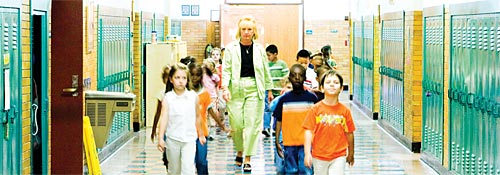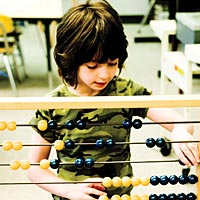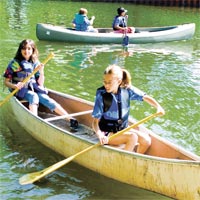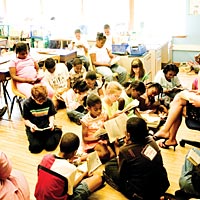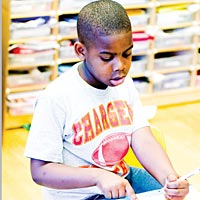|
NOTE: This story appeared in our October 2006 issue. For the latest data, see our October 2010 story. On the first day of school every year, fifth-grade teacher Peter Sompolski walks to the chalkboard in his classroom at Brook Forest Elementary School in Oak Brook and makes the same dumb mistake. He adds three and three and gets nine. >>>
Then I look around," he says. "Did I get shot down, did the world come to an end? No. I made a mistake, and nothing happened. So then it's everybody else's turn to come up to the board and make a mistake. One by one, each child in the room gets a chance to commit a mistake in front of everyone else. There's hesitance, followed by silliness, but soon the message is abundantly clear: room 204, Mr. Sompolski's class, is a place where it's OK, and even encouraged, to get the wrong answer. "You'll be making many more mistakes this year," he tells the kids. "That's how we're going to learn. If you will not let yourself make mistakes, you won't be able to learn." Sompolski's math stunt is just one moment in a school year that is filled with chances to learn-and to learn how to learn. "Those teachers are advocates for our children, all the way," says Kim Rosas, a mother of two students at Brook Forest. By encouraging children to make mistakes, tricking them into learning U.S. geography when they think they're just talking football, and even letting them camp out in his backyard, Sompolski is nourishing not only children's brains but their character-their entire selves. That approach, known in school circles as the "whole child" view, is a key piece of the all-around educational success that puts Brook Forest, Oak Brook's only elementary school, in the top ranks of Chicago magazine's first-ever list of the 115 best public schools in the region.
We tunneled into a mountain of data on the more than 1,740 public elementary, middle, and junior high schools in Chicago, the rest of Cook County, and the five surrounding counties, hunting for all-around top performers. And we found them. Kids learn well and achieve on standardized tests at these schools, but that's not enough. The top schools also serve parents and teachers well: class sizes are small but most budgets aren't huge; teachers are largely veterans and can count on a respectable salary that stokes their commitment. It's not an easy set of balls for school administrators to juggle, but some manage the trick nicely. In the chart on pages 94 to 101, we list the top schools in Chicago and each of the counties, as selected by Chicago magazine based on data from all public schools' 2005 report cards from the Illinois State Board of Education. Separately, we've identified 25 of the best private elementary schools in the region (see page 146), based on information provided by the individual schools. (See page 93 for an explanation of the data used to compile the charts.) Schools are configured differently around the region, and their programs and resources vary widely. The top city schools on our chart-Lenart, Decatur, Edison, and Keller-are specialty campuses, enclaves of intensive learning for superbright kids drawn from all over the city, but these schools spend the same $6,023 per pupil as all the city's 476 other elementary schools. Brook Forest, by contrast, draws children of all ability levels from a wide swath of small, tony Oak Brook (some children on the edges of the suburb go to schools in other towns), but it's in a district that spends a generous $9,440 per pupil, the most for any district on our chart. Every student at Lenart, the prestigious South Side magnet school, meets or exceeds state goals on standardized tests-not a surprise given its prerogative to enroll only the brightest. At Brook Forest, about 94 percent of students meet or exceed standards; that's an impressive figure when you consider that the test takers have a broader range of academic abilities than those at Lenart. The charts show how schools compare numerically, but that alone is too reductionist a way to view them. Like children, schools have many fundamental similarities, but they are also gloriously individual, each one's personality a manifestation of its unique circumstances.
The real differences lie not only in the data but in the ways the different schools attend to each child's needs. Is Brook Forest better because it spends more money and educates everybody? Well, can you quantify the extra layers of worldly education Lenart kids get by growing up in an urban mix instead of a securely suburban life? Or Lenart's providing a setting where smart kids don't feel isolated by their intellectual gifts? Is the fact that an Oak Brook child will spend kindergarten through eighth grades with the same 40 or 50 classmates a plus or a minus? "There are multiple factors that go into making a school a place where powerful learning can happen," says Richard Streedain, a professor of educational leadership at National- Louis University and a school principal for 25 years in Westmont, West Chicago, and Winnetka. He says the single best indicator of school quality may be an institutional commitment to deal with the whole child. "When small children say, ‘I like my teacher,' they're saying, ‘The teacher is addressing my social, emotional, moral, ethical, and intellectual needs,'" he explains. "‘The day goes pretty fast, and I feel important in my classroom.'" "We are all part of the puzzle for the success of that child," Sompolski says. "If we don't have the parents, the teacher, and the child working together, there can't be success." It may sound simplistic, but building that three-legged stool takes a certain amount of craft and attention to detail. One Brook Forest parent saw how it happens when her second grader was slow to grasp reading. The school's reading specialist pulled him into a skills group-and urged his mom to come along, too. "She wanted me to sit in the room when they were doing the lessons so I could take it home," this mother says. "I learned things like putting his finger under certain words to read the line, and how to break up syllables" by tapping once on her arm for each. It facilitates sounding the word out. "We did all that at home," she continues, and by third grade the boy was out of the special reading group. He is now reading above his grade level, according to his mom.
In Highland Park, where several schools are ranked on our Lake County chart (among them my own child's school, although that was not a factor in the selection), the mother of one Braeside School student with learning difficulties found a similar sense of partnership with the teachers. When her third grader couldn't get more than two of ten spelling words right three weeks in a row, she recalls, "I went in and said, ‘He's obviously not getting anything out of these tests but a feeling of defeat.' The answer wasn't ‘Too bad, he can't keep up.' It was ‘What do you think would work for him?'" The eventual solution was to give him an abbreviated list and a multiple-choice test on which he would identify the correct spelling. "The teachers wanted to work with me to work with him; they were willing to figure out a way to help him succeed enough to make it a meaningful kind of test," the mother says. Teaching the whole child does not equate to coddling or going soft; it's recognizing that young brains work best when comfortable. Most schools are far away from the old call-and-response style of teaching, where the teacher rattled off facts and students gulped them down just to rattle them back later. Schools have come to understand the fact that people have many different styles of learning; now they take it as a principle of their game plan. That's why when your third grader studies the pioneers and goes off to music class, music from the pioneer era is on the agenda, and why Sompolski has an NFL geography game, in which each student tracks the record of one pro football team, along the way learning about the city the team calls home. Walk into an elementary school today, and it's not long before you happen across kids making PowerPoint presentations, or using iMovie software to create their own videos, or even, as they do in some classrooms in School District 30 in Northbrook and Glenview, taking notes on personal digital assistants. It's no secret that contemporary children are steeped in technology; using it in the classroom cuts both ways-it enhances their tech skills at the same time that it puts them in a familiar environment. "Today's best pedagogy puts kids into a lot of really powerful learning experiences," Streedain says. "When you and I were in school, teachers just lectured, and if we got it, we got it. Now, if you're struggling with reading in first or second grade, but you know ‘My teacher likes the way I play ball and talks to me about sports and we can read about sports,' you're going to hang in there." Even when kids are as bright and as motivated to learn as they are at Lenart, says JoAnna Theodore, the principal, the process of learning has to be dynamic. "If we want to encourage creativity, divergent thinking, and higher-level thinking, we have to provide the venues for [students] to do that," she says. "We have to listen to them as much as we want them to listen to us. Do we always like what they say? No, but if they are going to be able to succeed outside of Lenart, they have to be able to formulate their thoughts and make the right decisions." When she arrived at Lenart as a teacher in the mid-1990s, Theodore recalls, "our basketball team could never win a game, and the teacher would say, ‘Just show them your test scores.' But I think we want these children to be more well-rounded." The school's pompon squad (from grades six through eight) was first in the city last year, and second this year.
Granted, many of the top schools on the magazine's chart are in relatively affluent areas where you would figure the parents cultivate a drive to learn because that's what sparked their own life successes. But parents, too, need to keep learning: at Lenart and other schools like it, the school year is dotted with seminars for parents on SENG, or the social and emotional needs of the gifted child, a complex topic you can't always nail down on intuition alone. Lenart's Theodore explains that programs like these cultivate parents' understanding of how and why the school clicks for their children, encouraging them to reinforce the school's methods at home. There's also an effort, she says, to "give the parents something they themselves can benefit from," such as technology classes for adults, an occasional program run by volunteers. "If you do something that is pertinent to the parents' lives, you make that link for them, and they buy into your school more," Theodore says. Teachers need to buy in, too, of course. Brook Forest third-grade teacher Elizabeth Sompolski, wife of Peter Sompolski, is president of the local teachers' union. She acknowledges that a major motivator for teachers is to feel integral to the machinery of education, and not like a mere cog. "When you come to work and you feel respected, you want to do your best," she says. "You feel valued; you feel that sense of empowerment. And it comes through in what you do in your classroom." Salaries in the Oak Brook school district, where Brook Forest is located, average $67,121, below those in nearby districts in Hinsdale, Naperville, and Burr Ridge. But class sizes and the ratio of students to teachers are notably smaller in Oak Brook than in those districts; clearly there's a tradeoff teachers make. The Sompolskis' children go to Naperville schools. "They have outstanding teachers and curriculum," their mother says. "But because of the school's size, they can't get the same feeling we have" at Brook Forest, which is a little more than half the size of her children's school. "We truly have this sense of knowing the children and the parents and working together closely with them. There are kids I haven't had in my classroom but I have a real sense of who they are and how they're developing. It makes for an ideal work situation for a teacher." Brook Forest parent Kim Rosas echoes that impression: "It's a pretty intimate environment," she says. "The small class size has been a hallmark of our school district." For students as well as teachers and parents, she says, "it builds a camaraderie that you don't see much anymore." It's true that there is a luxury in smallness, but no matter how big the school is, the web of relationships-parent to teacher, teacher to student, school board to teacher-determines how well the school succeeds at grooming children for success later in life. "This is a group process," says Elizabeth Webb Peterman, the principal of La Grange's Spring Avenue School, the top-ranked elementary school on our Cook County chart. "It takes every single person in this building, district, and community to make this school work." |
||||||||||||
| Chicago Magazine's Elementary School Rankings List | ||||||||||||
The A+ Team
We crunched data from more than 1,700 public elementary and middle schools in the Chicago area—evaluating everything from average class size to expenditures per student to standardized test results—and picked the 115 best. We also interviewed education experts to come up with 25 private schools deserving high marks.



